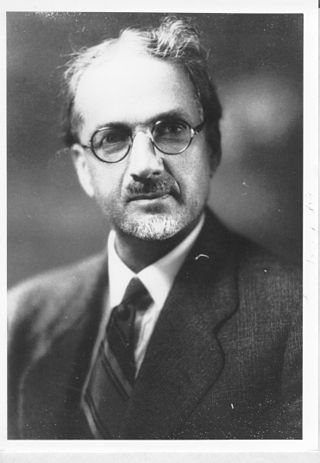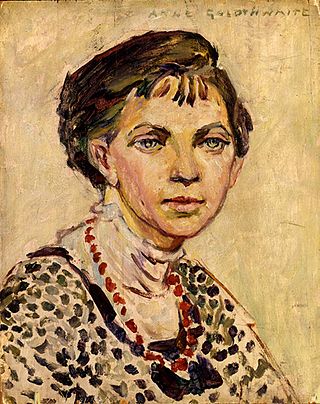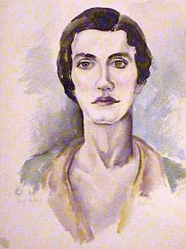Related Research Articles

Elaine Marie Catherine de Kooning was an Abstract Expressionist and Figurative Expressionist painter in the post-World War II era. She wrote extensively on the art of the period and was an editorial associate for Art News magazine.

Robert Henri was an American painter and teacher.

Albert Henry Krehbiel, was the most decorated American painter ever at the French Academy, winning the Prix De Rome, four gold medals and five cash prizes. He was born in Denmark, Iowa and taught, lived and worked for many years in Chicago. His masterpiece is the programme of eleven decorative wall and two ceiling paintings / murals for the Supreme and Appellate Court Rooms in Springfield, Illinois (1907–1911). Although educated as a realist in Paris, which is reflected in his neoclassical mural works, he is most famously known as an American Impressionist. Later in his career, Krehbiel experimented in a more modernist manner.

Arnold Blanch, was born and raised in Mantorville, Minnesota. He was an American modernist painter, etcher, illustrator, lithographer, muralist, printmaker and art teacher.

Anne Goldthwaite was an American painter and printmaker and an advocate of women's rights and equal rights. Goldthwaite studied art in New York City. She then moved to Paris where she studied modern art, including Fauvism and Cubism, and became a member of a circle that included Gertrude Stein, Henri Matisse, and Pablo Picasso. She was a member of a group of artists that called themselves Académie Moderne and held annual exhibitions.

Lucile Esma Lundquist Blanch was an American artist, art educator, and Guggenheim Fellow. She was noted for the murals she created for the U.S. Treasury Department's Section of Fine Arts during the Great Depression.
Caroline Wogan Durieux was an American printmaker, painter, and educator. She was a Professor Emeritus of Fine Arts at Louisiana State University, where she worked from 1943 to 1964.

Jennie Augusta Brownscombe was an American painter, designer, etcher, commercial artist and illustrator. Brownscombe studied art for years in the United States and in Paris. She was a founding member, student and teacher at the Art Students League of New York. She made genre paintings, including revolutionary and colonial American history, most notably The First Thanksgiving held at Pilgrim Hall in Plymouth, Massachusetts. She sold the reproduction rights to more than 100 paintings, and images of her work have appeared on prints, calendars and greeting cards. Her works are in many public collections and museums. In 1899 she was described by New York World as "one of America's best artists."
Vera Eugenia Andrus (1896–1979) was an American artist, and printmaker.
Yngve Edward Soderberg was an American artist whose career was centered on Mystic, Connecticut. He is credited with being a painter, etcher, writer, teacher, designer, and lithographer. He is best known for his etchings, America's Cup paintings and maritime watercolors.
Eleanor Ingersoll Maurice (1901–1995) was an abstract and realist painter. Her media included oil, watercolor, pencil drawings, and collages.

Natalie Smith Henry (January 4, 1907 – February 20, 1992) was an American artist who worked mostly in Chicago. She is best known for her Depression-era post office murals commissioned by the United States Department of the Treasury.
Mary Harvey Tannahill was an American painter, printmaker, embroiderer and batik maker. She studied in the United States and Europe and spent 30 summers in Provincetown, Massachusetts, with the artist colony there. She was instructed by Blanche Lazzell there and assumed the style of the Provincetown Printers. She exhibited her works through a number of artist organizations. A native of North Carolina, she spent much of her career based in New York.

Gladys Thayer (1886–1945) was an American painter and teacher.
Bertha Eversfield Perrie was an American painter. She has been described as "about the only famous Washington artist who was actually born in D.C."
Ruth Armer was an American abstractionist painter, teacher, art collector, and lithographer, from the San Francisco Bay area in California. Her art is held in the collections of San Francisco Museum of Modern Art, and the Fine Arts Museums of San Francisco.
Frances Julia Farrand Dodge was an American artist and teacher.

Edith Loring Getchell(1855 – 1940) was an American landscape painter and etcher, highly regarded for the "exquisite" tonalism of her etchings, drypoints and watercolors." Working during the "American Etching Revival," a period that lent legitimacy to an art form that had once been scorned as commercial, Getchell made use of the opportunities the vogue for etching gave her, despite a crowded field and the gender discrimination of her era. Considered one of America's leading etchers in her lifetime, Getchell's work is notable for its skill, its aesthetic values and its approach to depicting American landscape.

Ryah Ludins (1896–1957) was a Russian-born American muralist, painter, printmaker, art teacher, and writer. She made murals for post offices and other government buildings during the Great Depression and also obtained commissions for murals from Mexican authorities and an industrial concern. Unusually versatile in her technique, she made murals in fresco, mixed media, and wood relief, as well as on canvas and dry plaster. She exhibited her paintings widely but became better known as a printmaker after prints such as "Cassis" (1928) and "Bombing" drew favorable notice from critics. She taught art in academic settings and privately, wrote and illustrated a children's book, and contributed an article to a radical left-wing art magazine. A career spanning more than three decades ended when she succumbed to a long illness in the late 1950s.

Dorothy Lake Gregory (1893–1975) was an American artist best known for her work as a printmaker and illustrator of children's books. She took art classes in public school and at the age of fourteen began making drawings for a New York newspaper. She studied art in Paris in her late teens and thereafter took classes at Pratt Institute, the Art Students League of New York, and the Cape Cod School of Art. Her career as a professional artist began with her participation in an exhibition of paintings at the Art Students League in 1918. Her first book illustrations appeared three years later. She first showed prints in an exhibition held in 1935. She continued as artist, illustrator, and printmaker for most of the rest of her life employing throughout a different style for each of the three media. In 1956, a critic contrasted the "cubistic" painting style of that time with the book illustration style for which she was better known, saying he had heard gallery-goers incredulously remark, "But she can't be the same Dorothy Lake Gregory."
References
- ↑ "Margery A. Ryerson, Painter, Dead at 102". The New York Times. 8 April 1989.
- 1 2 3 "Margery Austen Ryerson (1886 - 1989)". Brier Hill Gallery.
- ↑ "Margery Ryerson | Smithsonian American Art Museum". americanart.si.edu.
- 1 2 3 4 5 6 "Margery Ryerson (1886 – 1989) @ James Cox Gallery at Woodstock". www.jamescoxgallery.com. Retrieved 2021-11-26.
{{cite web}}: CS1 maint: url-status (link) - 1 2 3 "Margery Ryerson - Biography". www.askart.com.
- 1 2 3 "Margery Ryerson: A Tribute 1886-1989". Flipsnack.
- ↑ "Margery Ryerson - Artist Facts". www.askart.com.
- ↑ "About Robert Henri". henri.